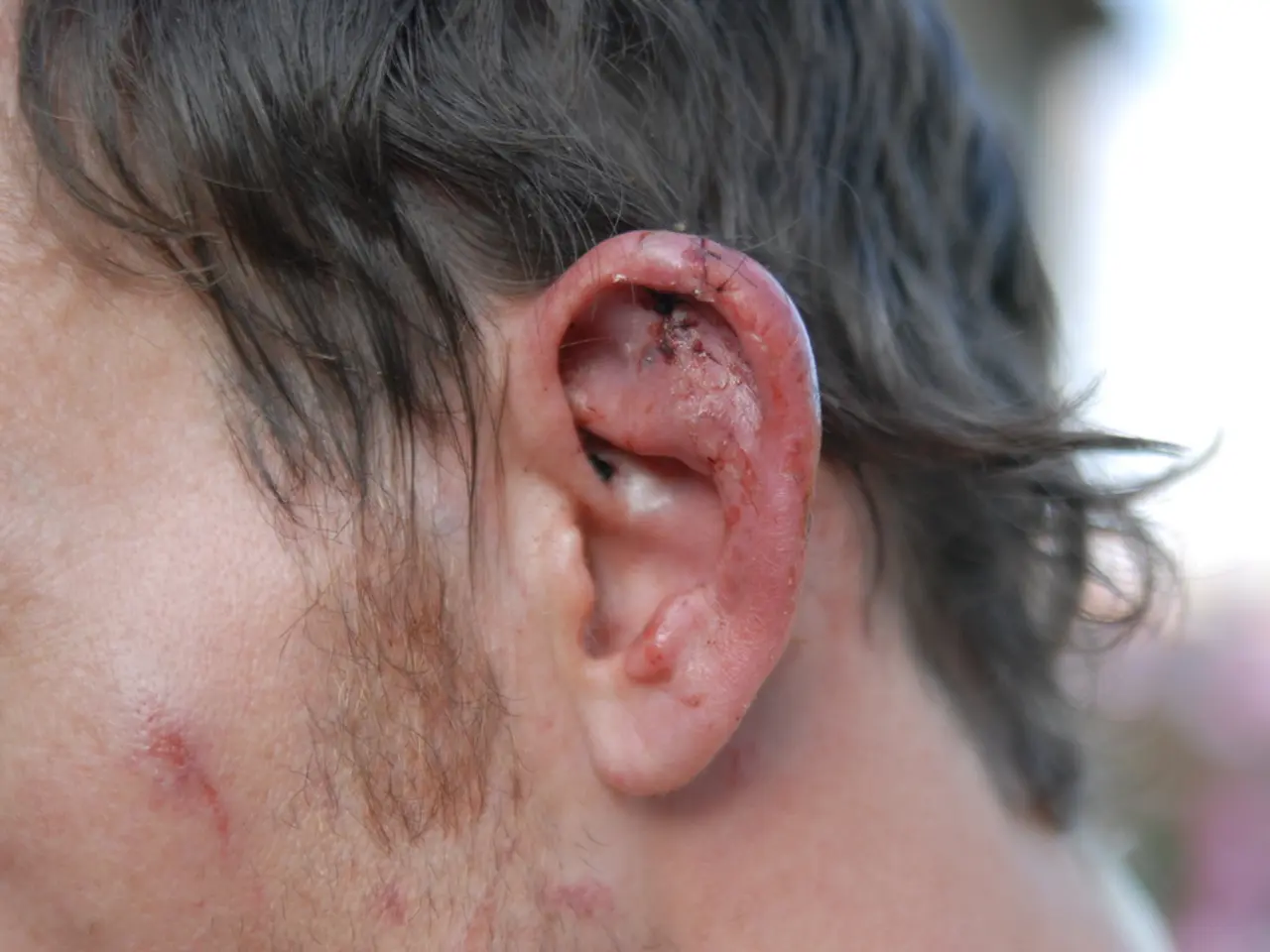Scrotal Cyst: Root Causes, Recognizable Signs, and Available Remedies
In the realm of male health, scrotal cysts are a common occurrence. These fluid-filled sacs can form on or inside the scrotum, causing various symptoms and requiring different treatment options. This article aims to shed light on two common types of scrotal cysts - sebaceous and epididymal cysts.
Sebaceous Cysts
Sebaceous cysts are benign lumps formed by blocked sebaceous glands in the scrotal skin. Filled with oily or putty-like material, they typically present as painless, whitish, yellowish, or skin-coloured lumps. These cysts may vary in size and number and can persist for months or years. If infected, they become painful, swollen, red, and may discharge foul-smelling pus. It's important to note that sebaceous cysts are not sexually transmitted or cancerous.
Diagnosis is predominantly clinical, and biopsy is rarely needed. Treatment is usually unnecessary unless for cosmetic reasons or if infection occurs, in which case antibiotics and surgical removal may be required. Preventing sebaceous cysts is difficult, but good hygiene and avoiding scrotal hair removal may reduce the risk. Prognosis is excellent, and cysts typically do not recur after removal.
Epididymal Cysts
Epididymal cysts, also known as spermatoceles, are fluid-filled sacs arising from the epididymis, a tube located at the back of the testicle that stores and carries sperm. They usually present as painless scrotal lumps and are generally benign. However, in rare cases, epididymal cysts can cause complications such as atypical testicular torsion—a twisting of the spermatic cord that cuts off blood supply to the testicle, requiring emergency intervention.
Diagnosis often involves ultrasound imaging, and treatment depends on symptoms: many epididymal cysts are monitored, but large or symptomatic cysts can be surgically removed.
Other causes of scrotal lumps or swelling include varicocele (enlarged veins in the scrotum causing a "bag of worms" feel and sometimes pain), hydrocele (fluid accumulation around the testicle), inguinal hernias, infections like epididymitis or orchitis, trauma, and testicular tumours. Each of these conditions presents with varying symptoms and requires distinct diagnostic and treatment pathways.
In conclusion, scrotal sebaceous cysts are common, benign, and usually painless lumps of blocked glands treated mainly for cosmetic reasons or infection. Epididymal cysts stem from the epididymis and may rarely cause complications such as torsion. Both differ from other scrotal lumps like varicocele, hydrocele, infections, hernias, or tumours, which may present with pain or systemic symptoms. Medical evaluation is essential to differentiate these conditions.
It's crucial for individuals to perform regular self-exams, particularly checking for swelling in the scrotum, gently feeling the testicles, and rolling them between the thumb and fingers to feel the entire surface. This simple test, which takes a few minutes, can help detect any abnormalities early. If a person notices any new lumps or swelling on their testicles or scrotum, they should speak with a healthcare professional immediately.
[1] Mayo Clinic. (2021). Sebaceous cyst. [online] Available at: https://www.mayoclinic.org/diseases-conditions/sebaceous-cyst/diagnosis-treatment/drc-20352727
[2] National Health Service (NHS). (2021). Varicocele. [online] Available at: https://www.nhs.uk/conditions/varicocele/
[3] National Health Service (NHS). (2021). Hydrocele. [online] Available at: https://www.nhs.uk/conditions/hydrocele/
[4] National Health Service (NHS). (2021). Testicular torsion. [online] Available at: https://www.nhs.uk/conditions/testicular-torsion/
[5] American Cancer Society. (2021). Testicular cancer. [online] Available at: https://www.cancer.org/cancer/testicular-cancer.html
- In addition to scrotal cysts, health-and-wellness discussions must include other medical-conditions like HIV, Hepatitis, Depression, COPD, Diabetes, Obesity, Dermatitis, Multiple Sclerosis, and conditions such as Ulcerative Colitis, Type of Sclerosis, Atopic Dermatitis, and Psoriasis.
- In the realm of male health, aside from scrotal cysts, conditions like HIV and depression become prevalent, often requiring predictive science and medical intervention.
- Good hygiene and avoiding scrotal hair removal may reduce the risk of Sebaceous cysts, but the prevention of other medical-conditions like HIV, Hepatitis, and Obesity require a comprehensive approach towards health-and-wellness and lifestyle modifications.
- Similar to a QR code providing quick access to information, self-exams can help predict abnormalities in health, especially when it comes to detecting new lumps or swelling in the scrotum related to conditions such as sebaceous cysts, hydrocele, or even testicular tumours.
- Atypical testicular torsion, a rare complication of epididymal cysts, shares similarities with certain medical-conditions, such as aspirin allergy or gluten intolerance, requiring timely diagnosis and treatment.
- The diagnostic and treatment pathways for scrotal conditions like varicocele, hydrocele, and testicular tumors differ from those for scrotal cysts, much like the differences in categorizing different types of cells in biology or understanding the functional differences between proteins in science.
- While sebaceous cysts can persist for months or years, sometimes without treatment, other medical-conditions like Diabetes and Obesity require continuous management for effective control.
- In discussions about mens-health, it's important to note that conditions like Hepatitis could lead to complications like liver damage, highlighting the need for regular medical checkups and vaccination campaigns, not just for scrotal cysts.
- Advancements in medical science have made it possible to treat conditions like COPD, Diabetes, and even HIV more effectively, enabling individuals to achieve a better quality of life, just like surgical removal of cysts can alleviate physical discomfort.
- Regular self-exams, coupled with medical consultations, can aid in the early detection of conditions like Varicose veins, Hydrocele, Testicular torsion, and even testicular cancer, emphasizing the significance of health-and-wellness surveillance beyond just checking for scrotal cysts.




